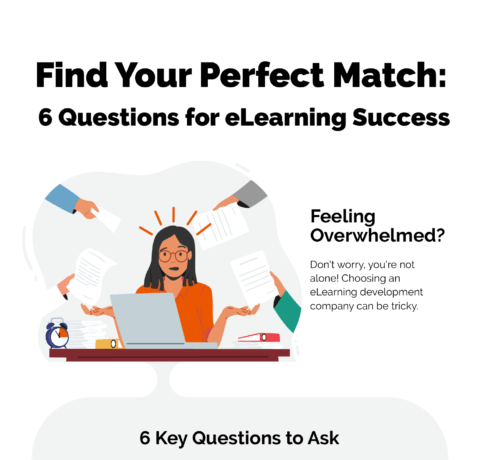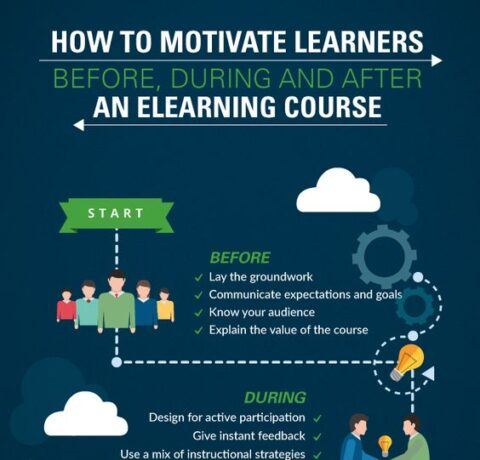Top 20 eLearning Statistics For 2019 You Need To Know - Infographic
The eLearning industry continues to expand, offering an ever-increasing array of eLearning tools to companies, government bodies, and individuals. The reach of eLearning today is greater than ever with the most rapid growth in emerging economies trying to close the education gap. In this infographic, we're going to take a look at 20 of the top eLearning statistics of 2019.
1. The global eLearning market was worth an impressive $107 billion in 2015
The global eLearning market was worth an impressive $107 billion in 2015 [1]. By 2025, however, Research and Markets believe that it will reach a staggering total market value of $325 billion [1].
2. The self-paced eLearning market will decline to $33.5 billion by 2021
The self-paced eLearning market, unlike the wider eLearning industry, is going through a period of secular decline and is expected to see its total revenues fall by 6.1% per year until 2021 [1]. The reason for the decline has to do with shifts in the industry. Self-paced learning sounds like a good idea in theory, but eLearning providers have found that, in general, it's not particularly useful.
3. 77% of U.S. companies used online learning in 2017
The percentage of US companies using online learning hit 77% in 2017 [1], the latest year for which figures are available. The reasons for this boil down to the growing realization of just how impactful eLearning has become. One of the main reasons US companies are so keen on eLearning is its ability to speed up employee training. In 2017, the Brandon Hall Group's HCM Outlook Survey found that eLearning could reduce employee training time by as much as 40-60% [2].
4. Comprehensive training programs lead to a 218% higher revenue per employee
Deloitte, a professional services and research company, estimates that the average employee needs to dedicate around 1% of their time per week to training. Doing this, according to Deloitte, enables the worker to stay up to date with best practices and developments in their industry. 1% of the working week isn't much time at all. It translates to 24 minutes per week or 4.8 minutes per day, assuming a 5-day working week [14].
5. Data suggests that when employers spend $1,500 per employee per year on training, they achieve improvements in profit margins of around 24%
Data suggests that when employers spend $1,500 per employee per year on training, they achieve improvements in profit margins of around 24% [8]. Furthermore, for every additional $680 a company spends, shareholder return rises by 6%. Investing in the knowledge capital of a company, therefore, is just as important as investing in the physical capital [8].
Traditionally, companies have been reluctant to train their employees. Most managers know that investing in people yields positive returns, but few are aware of the fact that eLearning affects both the numerator and the denominator of the calculation of the performance. eLearning is more effective than most managers believe at boosting the revenue or profit per employee (the numerator) and it's also less costly than commonly perceived (the denominator), increasing the total return per unit spent. This can be accomplished easily if the company opts for a value for money LMS.
6. Figures from an open university study suggest that eLearning cuts energy consumption by 90% and slashes CO2 by more than 85%
It should come as no surprise that eLearning is a far greener and more efficient method of training than face-to-face. Figures from an Open University study suggest that eLearning cuts energy consumption by 90% and slashes CO2 by more than 85% [1]. eLearning courses are, therefore, an essential pillar in the global fight against climate change. The world needs a new generation of people with the intellectual and educational capacities to take on the challenges of tomorrow.
7. For every dollar spent on eLearning, companies make back $30 in productivity
Productivity isn't just crucial to company bottom lines—it's vital for our economy as a whole. The higher it is, the more output that each person can generate using a given amount of input—something that ultimately drives higher living standards. If the product is software and the input is programmer time, then higher productivity would mean writing more software for a given amount of programmer time. IBM found that even though eLearning was costly, it led to substantial improvements in productivity. For every dollar spent, the company claims that it saw $30 in increased productivity [2].
8. The eLearning industry grew 900% since the turn of the century
Since 2000, revenues in the eLearning industry have grown by more than 900% [2]. And, as discussed, the trend isn't showing any signs of slowing down, with the industry expected to nearly triple in size by the year 2025 [2].
9. 72% of organizations believe that eLearning puts them at a competitive advantage
Given what we've discussed so far, it shouldn't come as a surprise that 72% of organizations believe that eLearning puts them at a competitive advantage [2]. eLearning is a flexible tool that firms can use to provide them with educational support when they need it. Keeping employees apprised of changes in the market is a significant challenge for many enterprises. Modern business practices move rapidly, and sometimes it's difficult for employees to keep up. Firms, therefore, need ways of quickly plugging knowledge gaps, as and when they occur. Managers need flexible training resources that they can use to help employees get their heads around new material or working practices. Companies that can develop their employees in real-time achieve a competitive edge over their rivals.
10. Data from a poll in 2015 found that only 32% of employees in the U.S. were "engaged" and that more than 51% were "unengaged"
Data from a Gallup poll in 2015 found that only 32% of employees in the US were "engaged" and that more than 51% were "unengaged" [9]. The definition of what it means to be engaged in one's job is a little slippery, but mostly it means that the employee is fully absorbed in what they're doing and will go out of their way to further the interests of the organization for which they work. Unengaged employees do not feel connected to their firm and may often say and do things that run counter to its objectives. Unengaged employees are much more likely to suffer from burnout and general malaise while at work. Unengaged employees are also a substantial drag on the productivity of the firm. Not only are they less committed to the work they do, but they also harm the team as a whole, reducing morale. Low morale can mean that your team gets much less done than they otherwise could. eLearning, however, may help. According to data from The Molly Fletcher Company, eLearning helps firms achieve an 18% boost in employee engagement leading to higher productivity and customer satisfaction [2]. Companies that provide employees with training opportunities open up the possibility of career progression and, at the very least, give them interesting cognitive tasks to break up the monotony of the day.
11. Actively Engaged Workforces Deliver 2.6 Times The Earnings-Per-Share Of Their Unengaged Counterparts
Companies are sometimes reluctant to train their workers because of the perceived negative impact that it will have on their earnings per share. But the data does not bear this out. Actively engaged workforces deliver 2.6 times the earnings-per-share growth of their unengaged counterparts [10]. The effect of human capital in firms is real. Making shareholders aware of the value of training remains an important objective of company management. Senior executives need to make the case that the more they invest in education, the higher rewards for everyone in the organization, not just employees who could take their skills elsewhere. eLearning also delivers higher levels of overall worker satisfaction. The performance of organizations increases when their employees feel happy.
12. The US Government Bought $2.59 Billion Worth Of Self-Paced eLearning Products
The US government is partly responsible for the dramatic uptick we've seen in the consumption of eLearning products over the past two decades. At the last count, the US government spent more than $2.59 billion on self-paced eLearning products for its staff and administrators—a considerable sum of money [1]. You wouldn't expect an agency like the US government to be up to date with the latest online learning technologies, but it is. The government is looking for ways to scale up its education efforts for its workforce while keeping costs as low as possible. It needs a flexible learning platform to provide value for money to taxpayers.
13. Total Government Spending Will Fall To $2.035 Billion By 2021
Just like the rest of the self-paced eLearning market, the demand from the government is expected to decline over the coming few years as newer, sexier methods come to the fore. Figures suggest that total government spending will fall to $2.035 billion by 2021 [1]. However, it is likely to remain an essential part of the mix, and the government will likely shift its budget over to new forms of training that work even more effectively. 65% of millennials in the US chose their job because of training opportunities [1].
14. The eLearning Market Is Now More Than 21 Years Old
While the first computerized training courses were developed in the 1960s, it wasn't until the advent of the internet that the eLearning industry took off. One of the pioneers in the space was the Open University, which wanted to find ways of using the World Wide Web and computers to provide remote learning experiences. The Open University imagined a world in which you could craft learning experiences in software (tailored to your specific needs) and then sell them over the internet for a fee. However, early attempts mostly fell flat because most of their customers didn't have home computers. By the 1980s, Apple had released the Mac and PCs were finally finding their way into homes and company offices. Suddenly, there was an opportunity to use computers to deliver training materials. By the late 1990s, some companies and educational institutions were offering courses online, and the modern era of eLearning had begun. Distance learning suddenly became a real possibility thanks to the radical cost declines that internet-enabled learning delivered. The 2000s saw an explosion in companies using eLearning to train their employees. Suddenly, firms were able to provide onboarding courses for new employees and provide top-ups for those who had been with the firm for a lot longer, all at low cost.
15. 65% Of US Faculty Support Open Educational Resources
Figures from Statista suggest that more than 65% of faculty support the use of Open Educational Resources (OER), such as eLearning courses [5]. Many more also support cutting-edge instructional methods. 39%, for instance, support gamification [5]. Support for MOOCs has been more muted. 37% of faculty said that they supported Massive Online Open Courses, but again MOOCs have not had the widespread impact that many technologists predicted a decade ago.
16. 43% Of US College Students Find Digital Learning Technologies "Extremely Helpful"
The US college dropout rate currently stands at somewhere between 50% and 60%, depending on which figures you believe [13]. College students, therefore, are keen to find anything that might help them make it through their four-year course and complete it on time. 43% have turned to digital learning technologies, including eLearning, to provide them with assistance. eLearning technologies not only help to compartmentalize learning into manageable chunks, but they also deliver a better learning experience than simply reading out of a book.
17. 67% Of Organizations Offer Mobile Learning
Today, more than 67% of organizations said that they offer mobile learning of one kind or another [1], with 99% of mobile users believing that mobile learning enhances their experience [14]. The mobile learning market is expected to continue to expand, reaching $37.6 billion by 2020—a substantial chunk of the overall market [14].
18. 49% Of Students Say That They Have Taken An Online Course In The Last 12 Months
The share of global students who have participated in an online course of one kind or another has exploded over the current decade. During the most recent survey period, more than 49% of students said that they had taken part in some form of eLearning activity in the last 12 months [3], up from 46% in 2013 [5].
19. 73% Of Students Are Unaware Of The Availability Of MOOCs
According to Statista, 73% of students don't know what a MOOC is [3], and a further 17% know what a MOOC is but haven't taken one [7]. Only 5% of students surveyed completed a MOOC [7], even though 9% had taken one in the year of the survey [7]. Part of the explanation for the lack of awareness comes down to the absence of effective marketing. MOOC providers need to give compelling reasons for people to take their courses to attract people. Examples of students taking MOOCs and then going on to enter their career of choice would be a good start.
20. eLearning Enables Students To Learn Five Times More Material For Every Hour Of Training
IBM is famous for its implementation of eLearning courses at its headquarters and across its global workforce. The company found that those enrolled in eLearning courses learned more than five times as much material compared to traditional lessons, allowing the company to make significant cost savings [2].
References:
-
- eLearning - Market Analysis, Trends And Forecasts
- Brandon Hall Group Research
- eLearning and digital education - Statistics & Facts
- Share of global students who have interacted with massive open online courses (MOOC) and CBE in the past year as of April 2015
- Share of global students who have taken an online course in the past year from 2013 to 2015
- Percentage of faculty worldwide who support less traditional and digital education models as of March 2015
- Worldwide self-paced eLearning market revenue from 2016 to 2021, by region (in billion U.S. dollars)
- Global student awareness of massive open online courses (MOOC) as of April 2015
- Employee Engagement in U.S. Stagnant in 2015
- Investors, Take Note: Engagement Boosts Earnings
- College Enrollment and Work Activity of Recent High School and College Graduates Summary
- Graduation rate from first institution attended for first-time, full-time bachelor’s degree- seeking students at 4-year postsecondary institutions, by race/ethnicity, time to completion, sex, control of institution, and acceptance rate: Selected cohort entry years, 1996 through 2009
- Since 2015, sharp rise in share of Republicans saying colleges have a negative effect on the country







You can adjust your cookie preferences here.